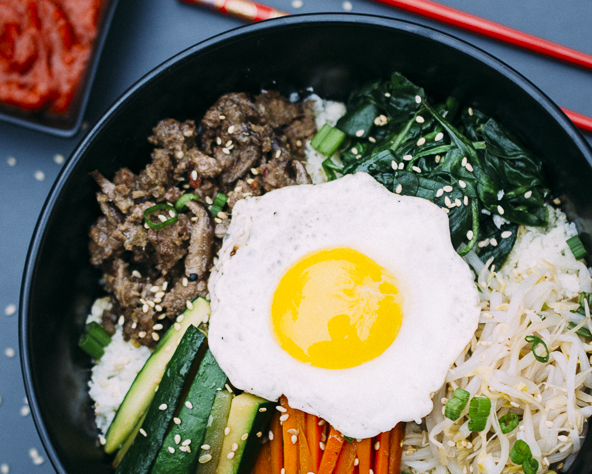With Asian flavors in every bite — ginger, sesame, Shiitake mushrooms, water chestnuts, and more — these Gyoza Meatballs are as close as we can...
Read MorePaleo Bibimbap
In each issue of Paleo Magazine, you’ll find my column in which I tell the story of a traditional international recipe and share a paleo-friendly version so you can make it at home. Here’s my take on the Korean classic bibimbap.
Every culture has it’s own version of a culinary hug in a bowl – a comforting pile of food that showcases local ingredients and is designed to feed the spirit, as well as the body. In East Asia, that dish has a name that’s fun to say: bibimbap. Pronounced BEE-beem-bop, it’s the signature dish of Korea, and it’s a delicious study in contrasts: Hot and cool. Soft and crisp. Mild and spicy. Salty and creamy.
Translated literally, the name means “mixed” (bibim) “rice” (bap) and traditionally, it’s an inviting combination of white rice, spicy-sweet chili sauce, a perfectly-runny egg, stir-fried vegetables, and seasoned meat, either ground beef or grilled beef known as bulgogi.
It’s no surprise that this vibrant dish has an equally colorful history. Bibimbap made its first appearance in print during the Joseon Dynasty (1392-1897) in the cookbook Siuijeonseo. The author of this comprehensive Korean recipe collection remains a mystery, but according to lore, the book was written by a lady of the yangban (noble) class. Swanky!
So, a fancy lady documented the dish, but who invented it? Again: intrigue!
One theory claims that bibimbap was a royal dish prepared for the king whenever he felt peckish and needed a snack between meals. A rival theory claims just the opposite: bibimbap is a humble peasant dish, the result of laborers who needed the convenience of a one-bowl meal while working the fields.
The third story is far more dramatic. In 1894, aggrieved peasants rebelled against the magistrate to protest the bogus laws, taxes, and fines he levied against them. During the Donghak Peasant Revolution, the rebels were forced to mix their meals together in one bowl because they didn’t have the plates – or the time – to fuss with side dishes.
Whatever the origin, bibimbap endures as a luscious, healthful meal in a bowl, especially when we swap some of the traditional elements with Paleo-approved ingredients. Overall, the sugar in the recipe has been reduced. The white rice of the original has been replaced with riced cauliflower, and date-sweetened sriracha stands in for Korean chili sauce made with soybean paste, rice powder, and sugar.
The key to the bold flavors of bibimbap is to cook the vegetables separately so they retain their individual textures. Don’t be put off by the long ingredients list! This dish is easy to make and comes together in just about an hour. The vegetables are cooked and cooled to room temperature while the rice, meat, and egg should be served hot, all the better to enjoy the beautiful contrasts.
I’ve used the more traditional ground meat in this recipe, but you can use thinly-sliced flank steak instead, and for fusion flair, you might add sliced avocado to the finished bowl. It’s not traditional, but I bet that aristocratic lady of the Siuijeonseo wouldn’t mind.
Paleo Bibimbap
Serves 4 — Don’t be put off by the long ingredients list! It’s mostly veggies, and the result is well worth the effort!
Ingredients:
Sweet Chili Sauce:
3 medjool dates, pitted
hot water
1/2 cup sriracha (Try Nom Nom Paleo’s homemade paleo sriracha.)
1 tablespoon toasted sesame oil
Rice:
2 heads cauliflower
2 tablespoons coconut oil, melted
2 teaspoons salt
Vegetables:
1 (14.5 oz) can bean sprouts, drained
2 scallions, white & green thinly sliced
1/2 cup rice vinegar
3 cloves garlic, minced
3 teaspoons coconut oil
coconut aminos, to taste
sesame oil, to taste
2 large carrots, cut into matchsticks
2 medium zucchini, cut into matchsticks
1/2 pound fresh baby spinach
Meat & Sauce:
2 teaspoons grated fresh ginger
2 cloves garlic, minced
1/2 teaspoon crushed red pepper flakes
1/2 cup unsweetened applesauce
1/4 cup coconut aminos
8 ounces shitake mushrooms, stemmed and thinly sliced
1 pound grass-fed ground beef
Egg:
4 large eggs
1 tablespoon coconut oil
Garnish:
toasted sesame seeds
sesame oil
sliced scallions
Directions:
Prep. Preheat the oven to 400F and cover two large, rimmed baking sheets with aluminum foil. Remove the pits from the dates and place in a small bowl. Cover with boiling water and allow to soak for 15 minutes. Meanwhile…
Make the rice. Break the cauliflower into florets, removing the stems. Place the cauliflower in a food processor and pulse until it looks like rice, 10 to 15 one-second pulses. Place the rice in a large bowl, add the melted coconut oil and salt, then toss until coated. Spread in a single layer on the baking sheets and roast in the oven until tender, 20 minutes. Turn off the oven and keep the rice warm inside until serving time.
Make the sauce. Drain the water from the dates. In a blender or food processor, purée the dates with the sriracha and sesame oil; set aside.
Make the vegetables. Place the bean sprouts, scallions, and rice vinegar in medium bowl. Toss to combine and set aside to allow the sprouts to “pickle” while you make the rest of the meal. Cook the carrots, zucchini, and spinach separately, following these instructions: Heat 1 teaspoon coconut oil in a large, non-stick skillet. Add 1 clove minced garlic, and as soon as it’s fragrant, add the vegetable. Toss with two wooden spoons, stir-frying until crisp-tender. When the vegetable is cooked to your liking, add a few splashes of coconut aminos, tossing to coat. Remove from heat, add a dash of sesame oil, and transfer cooked vegetable to a serving dish. Repeat with the remaining vegetables. Suggested order of cooking: carrots, zucchini, spinach.
Make the meat. In a small bowl, whisk the ginger, garlic, crushed red pepper flakes, applesauce, and coconut aminos. Re-heat the skillet you used for the vegetables over medium-high and crumble the ground beef into the pan. Add the mushrooms and stir-fry until the meat is no longer pink and the mushrooms are wilted. Add the sauce and cook until heated through and glazed, about 5 minutes. Transfer the meat to an oven-safe dish and place in the oven with the rice while you cook the eggs.
Make the eggs. In the same pan, heat coconut oil for 3 minutes over medium-high heat. Add the eggs one at a time and allow the white to set around the edges before adding the next egg. Cook until the whites are opaque and slightly crisp around the edges, and the yolks are just beginning to set, about 4 minutes.
Assemble. Place a mound of cauliflower rice in the bottom of a large bowl. Arrange the meat and vegetables in individual piles on top of the rice, and then top with a fried egg. Drizzle with a little sesame oil, and sprinkle with sliced scallions and sesame seeds. Serve Sweet Chili Sauce on the side.
Eat like a pro. The traditional way to eat bibimbap is to break the yolk so it runs over the other ingredients, then mix the whole thing with a spoon so it’s a textured blend of soft rice, crisp vegetables, spiced meat, and luxurious egg yolk.
For more delicious recipes like this one, subscribe to Paleo Magazine.
Still hungry? Try these
In each issue of Paleo Magazine, I share the story of a traditional recipe and adapt it to fit into a healthier paleo lifestyle. In the...
Read More






Yes. Yes. 1000x yes. I’ve only had bibimbaps as a vegan *tiny violin playing* but now that I’ve seen the light, I can’t wait to make this!
I actually brought bulgogi to work for lunch today (bulgogi tacos in lettuce leaves rock, btw) and now I’m sad that I’m not using my bulgogi for bimbimbap!! Oh well, I will make another batch of the meat, because this looks AWESOME!! Thank you for sharing such a great recipe!
Wow, totally making this! Thank you soooo much for the recipe!
This has become a huge hit in my house. Excellent!
This looks amazing. I LOVE bibimbap. Can’t wait to try this.
Made this on Saturday and it was amazing! One of our new favorites! Thank you for sharing!
I’m so glad you gave this recipe a try! Thanks for letting me know you liked it.
Thanks for the recipe! I’m curious though, all the bibimbap I’ve had used a raw egg, which then gets cooked in the hot molcajete-like bowl when it’s added on top of the steaming ingredients. Then you stir it super quickly to cook it. Have you tried it that way as well?
When I was doing my research, I didn’t find any recipes like that — all of them recommended cooking the egg until the whites were set and the yolk was still soft — but if you like it that way, I don’t see why you couldn’t prepare it to your liking.
Yay! We love bibimbap and this way I can have some and I betcha the kids won’t even notice!
This looks delicious and I am preparing it for dinner later this week. However, I am planning to prepare it with fresh bean sprouts rather than canned. Have you had any problems using fresh? Thanks! I love your books and recipes!
Fresh will work just fine. I used canned in my recipe for convenience for people who don’t have a well-stocked supermarket.
Wow! This was absolutely amazing! We have the real thing at a Korean restaurant and my husband kept exclaiming that this was just like the real thing. 😉 I didn’t have bean sprouts so I just pickled the scallions and substituted cabbage for zuchinni. YUM! Thanks for the recipe Melissa!
BTW, I just copy my copy of Well Fed 2 and can’t wait to dig in!
Hooray! I’m glad you and your husband enjoyed it! Great way to get in some veggies! Thanks for buying Well Fed 2; really appreciate the support.
This was so good!!! All the various steps did take a lot of time, so for me, this would only be cooked on a work from home day. I was really hoping it would taste as good as it smelled. Next time, I would add a lot more spinach. I also was unable to get fresh bean sprouts and either grocery store I was at this weekend, which was really odd. Now that I made this, I might not bother the next time. The amount of meat leftover versus the veggies will also have me add more veggies next time. Really happy with my meal tonight!!
Another fantastic recipe. We just devoured this, the only substitution I made was canned bamboo shoots instead of sprouts. So. Flippin’. GOOD!